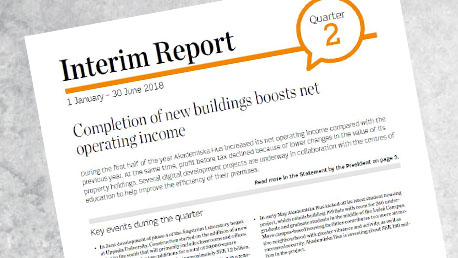Akademiska Hus Interim Report 1 January – 30 June 2018
Friday, 13 July 2018
During the first half of the year Akademiska Hus increased its net operating income compared with the previous year. At the same time, profit before tax declined because of lower changes in the value of its property holdings. Several digital development projects are underway in collaboration with the centres of education to help improve the efficiency of their premises.
Interim Report in brief
JANUARY–JUNE
- Rental revenue was SEK 2,986 million (2,782).
- Net operating income totalled SEK 2,107 million (1,962), an increase of SEK 145 million attributable to completion of new buildings.
- Changes in property values with an impact on profit totalled SEK 547 million (1,917), corresponding with 0.7 per cent (2.6) of the value of the properties.
- The total financing cost was SEK –544 million (–302), including a total of SEK –112 million (–103) in net interest income.
- Profit before tax for the period amounted to SEK 2,076 million (3,547) and profit for the period was SEK 1,769 million (2,744).
- Investment in redevelopment and new construction during the period totalled SEK 1,433 million (1,536).
- The yield (excluding properties under construction) was 5.4 per cent (5.5) on a rolling 12-month basis.
SECOND QUARTER
- Rental revenue was SEK 1,497 million (1,373).
- Net operating income was SEK 1,070 million (969), an increase of SEK 101 million, which is largely attributable to completion of new buildings.
- Changes in property values amounted to SEK 284 million (1,015).
- Net interest income declined by SEK 10 million to SEK –53 million.
- Profit before tax was SEK 1,058 million (1,809). The decrease mainly relates to a lower increase in the value of the properties.
Education needs are changing and higher education and research are increasingly influenced by external factors such as digitisation and globalisation. To address this development, Akademiska Hus works in close collaboration with the country’s centres of education to run a variety of projects, including visualisation solutions that allow both virtual and physical visits, as well as solutions to link together different systems for heating, ventilation and reservations.
“As a result of digitisation, the universities and colleges place greater demands on us to provide new, more efficient facilities adapted to learning and research in this new era. Our job is to help our customers improve the efficiency of their premises while making the campuses more attractive,” says Kerstin Lindberg Göransson, President, Akademiska Hus.
During the second quarter construction began on the first section of the expansion of the Ångström Laboratory in Uppsala. This project represents the largest joint initiative to date between Akademiska Hus and Uppsala University. Akademiska Hus is investing about SEK 1.2 billion in the project, which includes two additions of a total of 30,000 square metres, where the centre of education’s internationally renowned research and education can expand in an interdisciplinary environment. Ground was also broken for a housing project in Luleå. The project entails 199 flats with room for 266 undergraduate and graduate students in the middle of the Campus.
When several Karolinska Institutet departments move in to the newly built Biomedicum research laboratory in 2018, other buildings will be vacated and new activities can be created. Akademiska Hus is therefore investing almost SEK 100 million in a renovation project to create a meeting place for innovation in life science. The building will provide the Solna Campus with a long-awaited central gathering point where students, researchers, visitors, businesspeople and startup companies can converge for knowledge-sharing, development and innovation.
In collaboration with other stakeholders such as RISE, Akademiska Hus is launching RealEstateCore – a common digital language specially designed by property owners for buildings. The aim is to make it possible to control the large quantity of data generated by today’s more modern buildings. By using a uniform digital language, benefit can be maximised and new services developed to benefit tenants and suppliers.